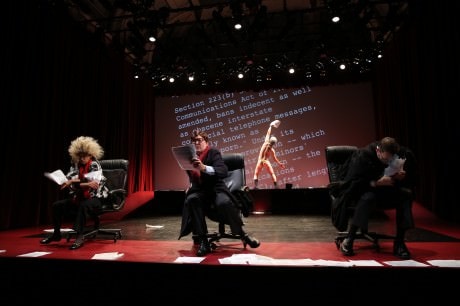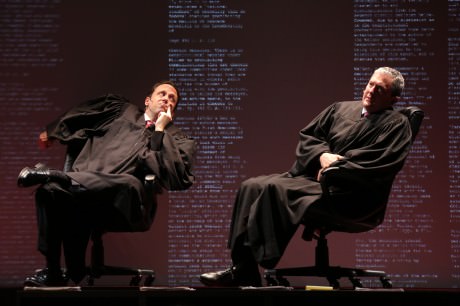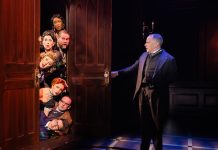Can conduct communicate? In what instances do practices of non-speech— such as music, money, or dancing— become speech in the sense that they are then protected by the Constitution under the first amendment, the freedom of speech? Woolly Mammoth Theatre Company brings this notion to the table in the penultimate offering of their 34th Season: ‘America’s Tell-Tale Heart’ by introducing Arguendo, a production conceived by Elevator Repair Service. Taking an instance of America’s rich judicial history— the oral argument of the case Barnes v. Glen Theatre Inc.— to the stage in Washington DC serves up double helpings of irony and symbolism as the Supreme Court is just around the corner and the issue at hand is nudity in performance. Directed by the company’s Artistic Director John Collins, Arguendo serves out the quote: ‘one man’s lyric may be another man’s vulgarity’ in an aesthetic and artistic approach: one man’s reverent fascination for the internal workings of our judiciary system may in fact be another man’s irreverent mockery of that exact institution.

Elevator Repair Services is doing something richly complex with the verbatim recording of the oral argument. Under the guidance of Director John Collins, the ensemble works to create a theatrical experience of the Supreme Court, breaking apart from the rigid stricture and Olympian structure of how far removed that branch of our government is by comparison to the rest of the governmental tree. Layering in movement that at first is stiff and formalized, Collins works to evolve the production into a dance of sorts, nearly all movement is choreographed and could be thusly argued imbuing meaning to its audience. The intricacies of the production’s development are fascinating to behold, watching the progression of the piece work from wholly formulated to chaotic pandemonium by the production’s close is sensational, inspiring and enthralling.
The inclusion of digital projections, created by Video Designer Ben Rubin, brings a modern element and a very uniquely disorienting approach to the production as a whole. Rubin’s stunning projection of both the exterior of the Supreme Court and the interior hall with the draped red curtain creates the judicial atmosphere to perfection. Adding to that the intense, albeit excessive, amount of text constantly displayed and in near-perpetual motion between the columns of the court room creates an overwhelming presence of the law all around the actors and the audience. Every time a previous case or law is mentioned a wooshing of text occurs (combined with the dizzying sound effects designed by Sound Designer Matt Tierney) and that bit of legal text is brought into large, sharp focus upon the screen. Tierney and Rubin’s designs also add sprinklings of humor to the production as the Justices throw their hands about and the screens of text whiz by, among other unsettling shifts in the screen.
Movement Dramaturg Katherine Profeta, working with Collins throughout this production creates mimicry and mockery, often considered the highest form of flattery, in the most reverent way possible for the actors to use in their proceedings. Little gestures like slumping or sleeping in the chairs when the actors embody particular Justices, or the way they encroach their physical presence around the advocate; all of these physical movement-based minutia both authenticates and theatricalizes the experience. There is something truly wondrous about watching all of these little moments and finding both the reality and the strong-handed humor in their execution.
Collins’ decision to have just 5 actors taking on a great deal of roles further breaks down the stringent formula with which the Supreme Court is often viewed. At any given time only three actors play all nine Justices, though four actors rotate into the roles throughout the course of the production. The chaos that ensues as these quick changes happen is at first gradual and quite humorous; growing exponentially uproarious as the play approaches pandemonium and its climax.
Collins’ work does include touching moments of tribute as well. An epilogue focusing on Justice Ruth Bader Ginsburg (played by Susie Sokol) draws a symbolic tie between the robes of the Supreme Court and the case witnessed during the production. While there is a certain level of humor and irreverence present, the overall production should be viewed in the best light possible in regards to the high respect of the Supreme Court. All of the spoken words came directly from the Justices’ mouths and as it turns out they are quite hilarious.
Performing in rotation as the Justices, among other characters, are Mike Iveson, Vin Knight, Susie Sokol, and Ben Williams. These four performers do an exceptional job of mastering their character switches. Even if it is the subtlest thing, like the way Iveson and Williams both adapt a slight twang to their voices when speaking as Chief Justice Rehnquist, or the way Sokol lowers the pitch of her voice when speaking as any of the male Justices. Every Justice has a physicality mastered down to the tiniest detail be it a tilt of the head, a confused expression on their face or an interjecting clearing of the throat and these four performers are phenomenal when it comes to mastering them.
Collins’ choice to include everything from the oral document, not just styles of speaking but stutters, interjections, and throat clears (just to name a few) is a bold one but it truly does reflect the exact nature of these Justices. Asking a core contingent of actors to deliver these types of vocal minutia convincingly is no small feat; a task at which they excel beyond compare. Without knowing that these stutters, ticks, pauses, and other verbal details were not their own one would never imagine them to be otherwise.

Williams and Iveson give exceptional performances as the advocates Mr. Uhl and Mr. Ennis respectively. Both adapt somewhat stoic and serious personalities for their roles as these men (not to say that at times their roles as Justices are anything less than serious) and endeavor to make these characters feel comfortable despite the disquieting scrutiny of the Supreme Court. Iveson deserves a nod for his explosive outburst once the true pell-mell chaos of the scene sets in.
To explain further all of the brilliant performing occurring in Argumendo would do it a great injustice; seeing this magnificent and extremely funny work will be a thought-provoking, eye-opening experience if nothing else. And it might even make you want to go and sit in on oral argument at the Supreme Court.
Running Time: Approximately 70 minutes, with no intermission.
Arguendo plays through April 27, 2014 at Woolly Mammoth Theatre Company— 641 D Street, NW, in Washington, DC. For tickets call the box office at (202) 393-3939, or purchase them online.





